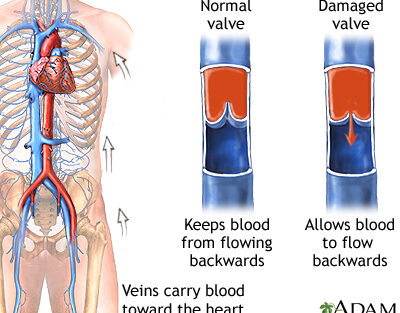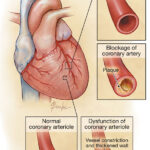Venous Insufficiency?
We at NJ Heart provide specialized latest state of the art treatment of varicose veins with minimal discomfort.
Venous insufficiency is a condition in which the veins have problems sending blood from the legs back to the heart.
Causes

Normally, valves in your deeper leg veins keep blood moving forward toward the heart. With long-term (chronic) venous insufficiency, vein walls are weakened and valves are damaged. This causes the veins to stay filled with blood, especially when you are standing.
Chronic venous insufficiency is a long-term condition. It is most commonly due to malfunctioning (incompetent) valves in the veins. It may also occur as the result of a past blood clot in the legs.
Risk factors for venous insufficiency include:
- Age
- Family history of this condition
- Female gender (related to levels of the hormone progesterone)
- History of deep vein thrombosis in the legs
- Obesity
- Pregnancy
- Sitting or standing for long periods
- Tall height
Symptoms
Pain or other symptoms include:
- Dull aching, heaviness, or cramping in legs
- Itching and tingling
- Pain that gets worse when standing
- Pain that gets better when legs are raised
Skin changes in the legs include:
- Swelling of the legs
- Irritated or cracked skin if you scratch it
- Red or swollen, crusted, or weepy skin (stasis dermatitis)
- Varicose veins on the surface
- Thickening and hardening of the skin on the legs and ankles (lipodermatosclerosis)
- Wound or ulcer that is slow to heal on the legs or ankles
Exams and Tests
We will do a physical exam and ask about your symptoms and medical history. Diagnosis is often made based on the appearance of leg veins when you are standing or sitting with your legs dangling.
A duplex ultrasound exam of your leg may be ordered to:
- Check how blood flows in the veins
- Rule out other problems with the legs, such as a blood clot
Treatment
You should take the following self-care steps to help manage venous insufficiency:
- Do not sit or stand for long periods. Even moving your legs slightly helps keep the blood flowing.
- Care for wounds if you have any open sores or infections.
- Lose weight if you are overweight.
- Exercise regularly.
You can wear compression stockings to improve blood flow in your legs. Compression stockings gently squeeze your legs to move blood up your legs. This helps prevent leg swelling and, to a lesser extent, blood clots.
When more advanced skin changes are present, we will
- Explain which skin care treatments can help, and which can make the problem worse
- May recommend some drugs or medicines that may help
We may recommend more invasive treatments if you have:
- Leg pain, which may make your legs feel heavy or tired
- Skin sores caused by poor blood flow in the veins that do not heal or recur
- Thickening and hardening of the skin on the legs and ankles (lipodermatosclerosis)
We at NJ Heart provide the following treatments:
- Procedures that can be done in our office in outpatient setting such as radiofrequency ablation and Venaseal which is a glue used to achieve similar results.
- Outlook (Prognosis)
Chronic venous insufficiency tends to get worse over time. However, it can be managed if treatment is started in the early stages. By taking self-care steps, you may be able to ease the discomfort and prevent the condition from getting worse. It is likely that you will need medical procedures to treat the condition.



